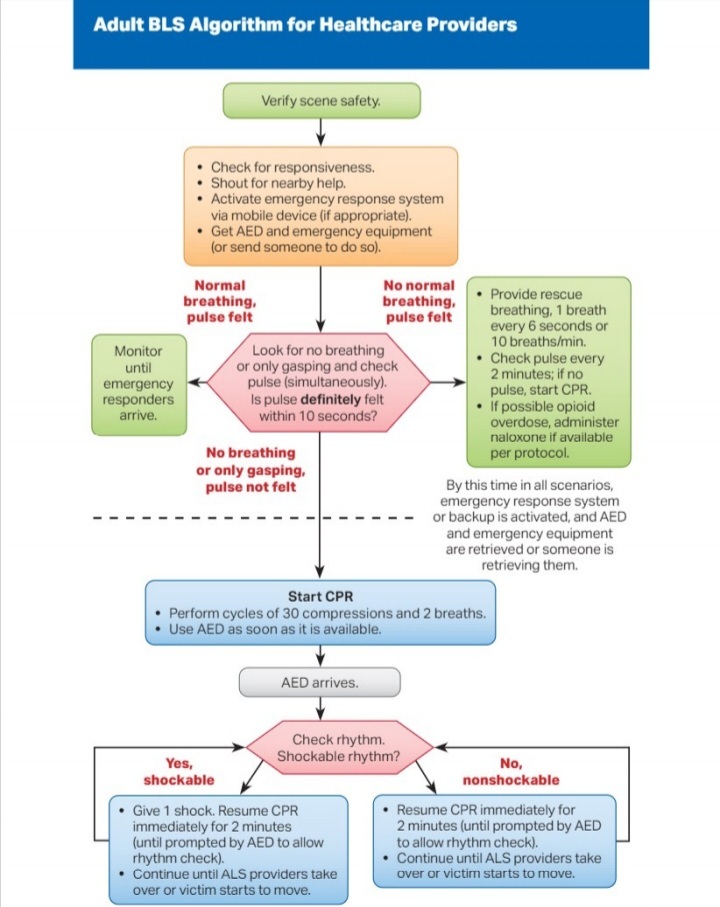(Images can be enlarged if needed)

Cardiac arrest, also known as Sudden Cardiac Arrest, is when the heart stops beating suddenly. The lack of blood flow to the brain and other organs can cause a person to lose consciousness, become disabled or die if not treated immediately.
The terms ‘heart attack’ and ‘cardiac arrest’ are often used interchangeably, but these are two different heart conditions.
A heart attack occurs when there is a blockage in the arteries that stops blood flow in the heart. Due to the lack of blood and oxygen flowing in the heart, the heart muscle tissue will become damaged. Heart attacks can increase the risk for cardiac arrest because heart attacks can alter electrical signals in the heart.
CPR – or Cardiopulmonary Resuscitation – is an emergency lifesaving procedure performed when the heart stops beating. Immediate CPR can double or triple chances of survival after cardiac arrest.
If someone experiences cardiac arrest, they need immediate treatment to increase the flow of oxygen-rich blood to their organs. CPR is the compression over the chest to manually pump a patients heart. Rescue breaths are preformed to provide oxygen to the body.
During CPR, proper hand placement on the lower half of the sternum is crucial. Placing hands over the sternum ensures effective chest compressions directly above the heart, optimizing blood circulation throughout the body.
According to the American Heart Association (AHA), the overall survival rate for out-of-hospital cardiac arrest is around 10%. However, survival rates can be improved if bystander CPR is started immediately. Studies have shown that bystander CPR increases the chances of survival for someone experiencing cardiac arrest. In fact, the AHA reports that survival rates increases to 40% or higher when bystander CPR is performed promptly. The surival rate is between 24% and 40% for those that happen in the hospital, according to the report published online in the Emergency Medicine Journal.
CPR is preformed between 100 - 120 beats per minute. Famously Staying Alive by the Bee Gees is the same beat. A large list of songs with the correct BPM can be found here
 The American Red Cross gives the following list of steps to asses if CPR is needed and how to preform:
The American Red Cross gives the following list of steps to asses if CPR is needed and how to preform:
1 CHECK the scene for safety, form an initial impression and use personal protective equipment (PPE)
2 If the person appears unresponsive, CHECK for responsiveness, breathing, life-threatening bleeding or other life-threatening conditions using shout-tap-shout
3 If the person does not respond and is not breathing or only gasping, CALL 9-1-1 and get equipment, or tell someone to do so
4 Kneel beside the person. Place the person on their back on a firm, flat surface
5 The American Red Cross CPR guidelines recommend 100 to 120 chest compressions per minute, 30 at a time. Remember these five points:
Hand position: Two hands centered on the chest
Body position: Shoulders directly over hands; elbows locked
Compression depth: At least 2 inches
Rate of compressions: 100 to 120 per minute
Allow chest to return to normal position after each compression
6
Give 2 breaths
Open the airway to a past-neutral position using the head-tilt/chin-lift technique Pinch the nose shut, take a normal breath, and make complete seal over the person’s mouth with your mouth. Ensure each breath lasts about 1 second and makes the chest rise; allow air to exit before giving the next breath Note: If the 1st breath does not cause the chest to rise, retilt the head and ensure a proper seal before giving the 2nd breath If the 2nd breath does not make the chest rise, an object may be blocking the airway
7 Continue giving sets of 30 chest compressions and 2 breaths. Use an AED as soon as one is available! Minimize interruptions to chest compressions to less than 10 seconds.
Sources:
https://www.hopkinsmedicine.org/health/conditions-and-diseases/cardiac-arrest
https://cpr.heart.org/en/resources/cpr-facts-and-stats
https://www.mycprcertificationonline.com/blog/cpr-success-rate
Instructional images from the AHS Basic Life Support Manual (2020)
Join our public Matrix server! https://matrix.to/#/#tracha:chapo.chat
As a reminder, be sure to properly give content warnings and put sensitive subjects behind proper spoiler tags. It’s for the mental health of not just your comrades, but yourself as well.
Here is a screenshot of where to find the spoiler button.



I hope you dont mind me responding to this
I was just about to start responding to this point by point, lol, phone in one hand, spoon in the other atm. Compromise: respond to some points.
But yes, kink was a huge part of my life for most of it, so maybe I qualify as having it as a special interest too. I have stories lol, too many stories, some of it is wrapped up in trauma like you said. It always surprises me how willing people are to share about this kind of stuff - its really heartwarming to me, as I prefer to be completely open to people I trust (and its helpful too, I need second opinions…)
This bit is new to me, and I am filled with endless curiously about the intersections here, most of my experience was before I was aware I was ND (well, technically I was diagnosed ADHD but I didn’t realise the rest of it or how much that impacted my life). I first encountered this bit in Unmasking Autism about the connection with kink, and it fascinates me. I’m not sure if there’s a lot of resources on this but I would definitely read a good book on the subject.
fuck yes this is literally drugs to me
waow
Okay sounds good, truly you are not out of spoons, you are bespooned, lol.
This sort of thing with people is very new to me so I’m all fascinated and shit, very silly of me. I often find many people are very understandably not that open about it, and usually I try not to pry so y’know. It is great though, really shows me why there is a “kink community” to begin with, I suppose.
Blegh I still really need to read Unmasking Autism and stop being an autism lib… I think that’s the only reading on the subject I know of, so I’m curious about that too. I just keep noticing (noticing!) the sensory interplay and stuff and I’m like waow, autism kink…
spoiler
lol I didn’t even think of it with spoons theory, I was eating breakfast haha but felt absolutely compelled to respond, I am very skileld
I don’t think it’s silly at all, I’m the same way when I discover something new that excites me. Happy to help where I can :), I think largely I don’t regret any of the kink stuff, even if I do regret some relationships etc. and I’ve read a couple of books on the subject too
I found the book easy to get into, but that was early on in the “wait am I…” journey. But Devon doesn’t go too deep into it, I wish there was an entire chapter on it lol. TELL ME WHAT I NEED, DEVON!!!
Yeah bigtime, looking back I think a lot of the people I did kink stuff with were ND in some fashion, too (note: this may be selection bias), maybe Devon has a point about the community being “full of autistic people” or whatever phrasing he used.
:)
spoiler
Clearly
More silly because it took me so long, I guess everyone takes different time though. Also waow kink theory…
Fr it should be illegal to just lightly touch on that, we need to know more.
Hmmmmmmm curious… autism and kink together again, many such cases apparently… whenever authors make dork unqualified statements like that I always want to grill them about it.
spoiler
Yeah, everyone’s got their own pace for things, there is no “right” … I remind myself of this sometimes…
lol yes Devon, what are you doing? I’m sure he’s written blog posts about it, haven’t gone looking though.
Yes, unfortunately it was an unqualified statement. But I suspect a lot of the people who actually stick around for me are ND.
spoiler
I have to remind myself also…
Oh are the blog posts cool though??? Curious now…
Based, correct, very cool, love to see it.
https://substack.com/@drdevonprice I haven’t browsed much but he has a Substack ig, (I barely know what Substack is)
haha, yep, fingers crossed that the NDs will stick around too :) (this sentence made no sense, i am tired)